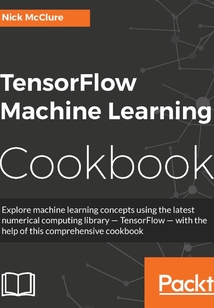舉報 

會員
TensorFlow Machine Learning Cookbook
最新章節:
Index
Exploremachinelearningconceptsusingthelatestnumericalcomputinglibrary—TensorFlow—withthehelpofthiscomprehensivecookbookAboutThisBook?YourquickguidetoimplementingTensorFlowinyourday-to-daymachinelearningactivities?Learnadvancedtechniquesthatbringmoreaccuracyandspeedtomachinelearning?UpgradeyourknowledgetothesecondgenerationofmachinelearningwiththisguideonTensorFlowWhoThisBookIsForThisbookisidealfordatascientistswhoarefamiliarwithC++orPythonandperformmachinelearningactivitiesonaday-to-daybasis.Intermediateandadvancedmachinelearningimplementerswhoneedaquickguidetheycaneasilynavigatewillfindituseful.WhatYouWillLearn?BecomefamiliarwiththebasicsoftheTensorFlowmachinelearninglibrary?GettoknowLinearRegressiontechniqueswithTensorFlow?LearnSVMswithhands-onrecipes?Implementneuralnetworksandimprovepredictions?ApplyNLPandsentimentanalysistoyourdata?MasterCNNandRNNthroughpracticalrecipes?TakeTensorFlowintoproductionInDetailTensorFlowisanopensourcesoftwarelibraryforMachineIntelligence.TheindependentrecipesinthisbookwillteachyouhowtouseTensorFlowforcomplexdatacomputationsandwillletyoudigdeeperandgainmoreinsightsintoyourdatathaneverbefore.You’llworkthroughrecipesontrainingmodels,modelevaluation,sentimentanalysis,regressionanalysis,clusteringanalysis,artificialneuralnetworks,anddeeplearning–eachusingGoogle’smachinelearninglibraryTensorFlow.ThisguidestartswiththefundamentalsoftheTensorFlowlibrarywhichincludesvariables,matrices,andvariousdatasources.Movingahead,youwillgethands-onexperiencewithLinearRegressiontechniqueswithTensorFlow.Thenextchapterscoverimportanthigh-levelconceptssuchasneuralnetworks,CNN,RNN,andNLP.OnceyouarefamiliarandcomfortablewiththeTensorFlowecosystem,thelastchapterwillshowyouhowtotakeittoproduction.StyleandapproachThisbooktakesarecipe-basedapproachwhereeverytopicisexplicatedwiththehelpofareal-worldexample.
目錄(106章)
倒序
- coverpage
- TensorFlow Machine Learning Cookbook
- Credits
- About the Author
- About the Reviewer
- www.PacktPub.com
- eBooks discount offers and more
- Customer Feedback
- Preface
- What this book covers
- What you need for this book
- Who this book is for
- Sections
- Conventions
- Reader feedback
- Customer support
- Chapter 1. Getting Started with TensorFlow
- Introduction
- How TensorFlow Works
- Declaring Tensors
- Using Placeholders and Variables
- Working with Matrices
- Declaring Operations
- Implementing Activation Functions
- Working with Data Sources
- Additional Resources
- Chapter 2. The TensorFlow Way
- Introduction
- Operations in a Computational Graph
- Layering Nested Operations
- Working with Multiple Layers
- Implementing Loss Functions
- Implementing Back Propagation
- Working with Batch and Stochastic Training
- Combining Everything Together
- Evaluating Models
- Chapter 3. Linear Regression
- Introduction
- Using the Matrix Inverse Method
- Implementing a Decomposition Method
- Learning The TensorFlow Way of Linear Regression
- Understanding Loss Functions in Linear Regression
- Implementing Deming regression
- Implementing Lasso and Ridge Regression
- Implementing Elastic Net Regression
- Implementing Logistic Regression
- Chapter 4. Support Vector Machines
- Introduction
- Working with a Linear SVM
- Reduction to Linear Regression
- Working with Kernels in TensorFlow
- Implementing a Non-Linear SVM
- Implementing a Multi-Class SVM
- Chapter 5. Nearest Neighbor Methods
- Introduction
- Working with Nearest Neighbors
- Working with Text-Based Distances
- Computing with Mixed Distance Functions
- Using an Address Matching Example
- Using Nearest Neighbors for Image Recognition
- Chapter 6. Neural Networks
- Introduction
- Implementing Operational Gates
- Working with Gates and Activation Functions
- Implementing a One-Layer Neural Network
- Implementing Different Layers
- Using a Multilayer Neural Network
- Improving the Predictions of Linear Models
- Learning to Play Tic Tac Toe
- Chapter 7. Natural Language Processing
- Introduction
- Working with bag of words
- Implementing TF-IDF
- Working with Skip-gram Embeddings
- Working with CBOW Embeddings
- Making Predictions with Word2vec
- Using Doc2vec for Sentiment Analysis
- Chapter 8. Convolutional Neural Networks
- Introduction
- Implementing a Simpler CNN
- Implementing an Advanced CNN
- Retraining Existing CNNs models
- Applying Stylenet/Neural-Style
- Implementing DeepDream
- Chapter 9. Recurrent Neural Networks
- Introduction
- Implementing RNN for Spam Prediction
- Implementing an LSTM Model
- Stacking multiple LSTM Layers
- Creating Sequence-to-Sequence Models
- Training a Siamese Similarity Measure
- Chapter 10. Taking TensorFlow to Production
- Introduction
- Implementing unit tests
- Using Multiple Executors
- Parallelizing TensorFlow
- Taking TensorFlow to Production
- Productionalizing TensorFlow – An Example
- Chapter 11. More with TensorFlow
- Introduction
- Visualizing graphs in Tensorboard
- There's more…
- Working with a Genetic Algorithm
- Clustering Using K-Means
- Solving a System of ODEs
- Index 更新時間:2021-04-02 20:36:55
推薦閱讀
- 未解之謎(下)
- 快修巧修新型液晶平板電視機
- 電子產品結構工藝
- 從算法到電路:數字芯片算法的電路實現
- 5G技術與應用
- VoLTE端到端業務詳解
- 通信工程綜合實訓
- 如影隨形:無處不在的無線電波
- 現代移動通信技術與系統(第2版)
- 手繪圖說電子電路圖
- 光通信波段激光頻率環的實現及測速應用
- 3D顯示技術
- 移動通信終端設備(手機)維修實訓
- LTE射頻技術及設備檢測
- Protel DXP 2004入門與提高
- 移動增值業務網絡及其運營
- 高可靠性電子產品工藝設計及案例分析
- 通信工程監理實務
- 密碼算法應用實踐
- 通信專業綜合能力與實務:互聯網技術
- 4G無線網絡原理及優化
- 高頻開關電源設計與應用實例
- 數字通信技術
- 軍事通信網電源系統及維護
- 典型開關電源電路識圖與應用快捷入門
- Vivado/Tcl零基礎入門與案例實戰
- 西門子S7-200/300系列PLC入門
- UHF RFID標簽天線設計、仿真及實踐
- Packet Tracer Network Simulator
- 通信電源設備與維護

